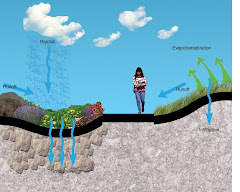Throughout the summer, the team has been observing the Loop with it's plants, soil, and other visiting creatures. One very interesting thing that has occured has been found around the grasses' roots and the surrounding soil. They are thin, long threads or strands like spaghetti, which push their way between soil particles, roots, and rocks. These strands are called hyphae and are microscopic cells of Fungi.
Fungi perform important services related to water dynamics, nutrient cycling, and disease suppression. Along with bacteria, fungi are important as decomposers in the soil food web. They convert hard-to-digest organic material into forms that other organisms can use. Fungal hyphae physically bind soil particles together, creating stable aggregates that help increase water infiltration and soil water holding capacity. The type found on the Dixie Loop's plants are mycorrhizal fungi, which colonize plant roots. In exchange for carbon from the plant, mycorrhizal fungi help solubolize phosphorus and bring soil nutrients (phosphorus, nitrogen, micronutrients, and perhaps water) to the plant.
Fungal hyphae physically bind soil particles together, creating stable aggregates that help increase water infiltration and soil water holding capacity. The type found on the Dixie Loop's plants are mycorrhizal fungi, which colonize plant roots. In exchange for carbon from the plant, mycorrhizal fungi help solubolize phosphorus and bring soil nutrients (phosphorus, nitrogen, micronutrients, and perhaps water) to the plant.
So! The spaghetti looking web in the soil helps our plants and shows a healthy, living soil.
Mycorrhizal Fungal Hyphae on the roots of a young pine tree, which grew in a container.



No comments:
Post a Comment